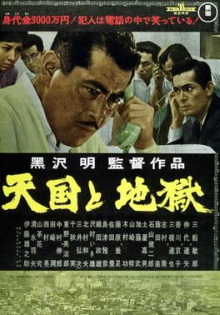We’ve seen plenty of films by Akira Kurosawa already but we’re far from done. It’s another film set in post-war Japan and is loosely based on an American novel. It starts out as an old-fashioned kidnapping story of a type that we don’t really see nowadays any longer but nothing too remarkable. So it’s only when we see the police embark on a massive manhunt for the perpetrator that the film truly comes into its own. The investigation is so sophisticated and the step by step process shown here so detailed that I felt compelled to check if this was based on a true story.
While trying to seize full control of a shoe company, businessman Kingo Gondo receives a call saying that his son has been kidnapped. It soon turns out the kidnapper made a mistake and grabbed his driver’s son instead. Nonetheless he insists on getting the ransom and threatens to kill the boy. Gondo is able to pay but the amount would leave him bankrupted and indebted. He calls the police and refuses to pay. Yet he relents after his wife and son begs him to do so. The kidnapper gives detailed instructions on how to prepare the cash and instructs them to drop the bags from a moving train, making it impossible for the police to track the handover. After the boy is released unharmed, the police reveal the details of the case to the public. Gondo’s generosity and personal sacrifice makes him a national hero and the police deploys just about every officer in the city to hunt for the kidnapper.
This film is probably longer than it needs to be. It takes its time to setup Gondo’s life as well as his mansion on top of a hill with expansive views of its surroundings. The arrogance embodied by the mansion looking down on everyone else is in fact what motivates the kidnapper. Later the police also trail the kidnapper for quite some time, which Kurosawa seems to regard as an opportunity to film scenes of the correspondingly “low” parts of society: an American-style dancing hall and an alley where the drug addicts of the city hang out. His attention to detail in laying out these scenes as well as showing every step of the police’s efforts is what really impresses me here. One notable example is how they find the place where the kidnapper kept the child through two entirely separate trails of clues working independently of each other. The police are portrayed as being competent and highly motivated, calling in experts who are able to extract information from tiny clues like the sound of a train in the background of a telephone call or the mud splattered on a car. This was not in fact based on a real story and the script was written by Kurosawa’s habitual team of collaborators. I suppose they must have done their homework and really liked the idea of making such a complex police procedural.
The imagery of the homes of Gondo and the kidnapper being literally high and low according to their stations in life is too obvious to be very interesting. But it is notable how right-wing and conservative this film is. Gondo may be immensely rich but Kurosawa asserts that he worked hard for it and is magnanimous in deploying that wealth for a moral cause. The police too recognizes Gondo’s noble sacrifice and not only works hard to catch the kidnapper but does so in a way that maximizes the punishment. Meanwhile the kidnapper is shown to be both morally and psychologically weak even if he was born into unfortunate circumstances. It’s impossible to miss that he is also someone who frequents dance halls and is familiar with drug dens, further attesting to him being an undesirable member of society. Meanwhile Gondo’s grateful chauffeur Aoki is subservient to the point of demeaning himself. Right-wing views this extreme might have been normal then but is pretty much unacceptable these days.
I very much enjoyed this as a traditional police procedural that emphasizes the step-by-step legwork of a manhunt rather than the modern approach of showing it as a dramatic contest of wills. Here Gondo makes the decision to pay the ransom but is uninvolved with the investigation itself. On the part of the police, Tokura heads the effort but the film clearly shows that the hunt is a group effort involving the contributions of many people. Thematically, the hard conservative views are hard to stomach and it is different from what we usually see today and it’s good to remind ourselves that such views used to prevail and might still be rife in some quarters today.
